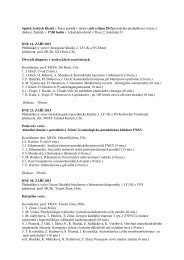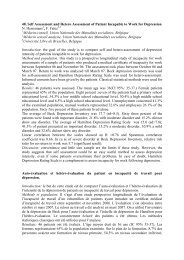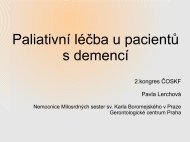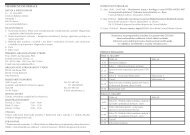ABSTRACTS â ORAL PRESENTATIONS - AMCA, spol. s r.o.
ABSTRACTS â ORAL PRESENTATIONS - AMCA, spol. s r.o.
ABSTRACTS â ORAL PRESENTATIONS - AMCA, spol. s r.o.
Create successful ePaper yourself
Turn your PDF publications into a flip-book with our unique Google optimized e-Paper software.
European Myeloma Network (EMN) was working on standardization of this analytical<br />
method and its implementation into routine clinical examination of MG cases (Rawstron<br />
et al., 2008). Thus a uniform protocol for the analysis of plasma cell dyscrasias (PCD)<br />
developed by EuroFlow consortium is widely recommended for MG analyses, especially<br />
in clinical studies (van Dongen et al., 2012).<br />
Aim: Analysis of different MG cases using Euroflow settings and validation/verification of<br />
this method for routine analyses.<br />
Subjects and methods: There were analysed 104 newly diagnosed MGs included 62<br />
multiple myeloma (MM) patients and 42 subjects with monoclonal gammopathy of<br />
undetermined significance (MGUS). Two 8-colours PCD tubes were prepared according<br />
to EuroFlow standard operation procedure (SOP) and analysed on flow cytometer used<br />
EuroFlow settings. Acquired data were reanalysed by Infinicyt software and compare<br />
with common analyses done in laboratory.<br />
Results: Using EuroFlow approach for MG analyses did not show any significant<br />
difference when compared to common plasma cell (PC) analyses. PCs were detectable,<br />
although CD138-Pacific Orange and lambda-APCH7 were not very bright in some cases.<br />
Merging of standardized data from two 8-colours PCD tubes increased number of<br />
analysed PCs what could overcome problem with low PC percentage, but a problem with<br />
clonality assessment remains. When other MGs than MM are analysed (MGUS with low<br />
PC infiltration, primary amyloidosis, lymphoplasmocytic lymphoma etc.) and different<br />
PC/plasmablast/B cell subpopulations should be detected, common analysis provides<br />
better identification of clonal cells. On the other hand, EuroFlow approach brings more<br />
information than common analysis and allows detection of specific PC phenotype. The<br />
important disadvantage of this approach is the price of some monoclonal antibodies and<br />
also specific software which is relatively high and thus unavailable for small laboratories.<br />
Conclusion: Analyses of MGs using EuroFlow settings are useful especially for<br />
reference laboratories participating in clinical studies as this approach allows sharing of<br />
standardized data for further analyses.<br />
Acknowledgements<br />
This work was supported by MSM0021622434, IGA NT12425 and GACR P304/10/1395<br />
grants.<br />
References<br />
1. Paiva, B., Almeida, J., Pérez-Andrés, M. et al.: Utility of flow cytometry<br />
immunophenotyping in multiple myeloma and other clonal plasma cell-related disorders.<br />
- Cytometry B Clin Cytom 78(4): 239-252, 2010.<br />
2. Rawstron, A.C., Orfao, A., Beksac, M. et al.: Report of the European Myeloma<br />
Network on multiparametric flow cytometry in multiple myeloma and related disorders.<br />
- Haematologica 93(3):431-438, 2008.<br />
3. van Dongen, J.J., Lhermitte, L., Böttcher, S. et al.: EuroFlow antibody panels for<br />
standardized n-dimensional flow cytometric immunophenotyping of normal, reactive<br />
and malignant leukocytes. - Leukemia 26(9):1908-1975, 2012.<br />
Analytical Cytometry VII 165








